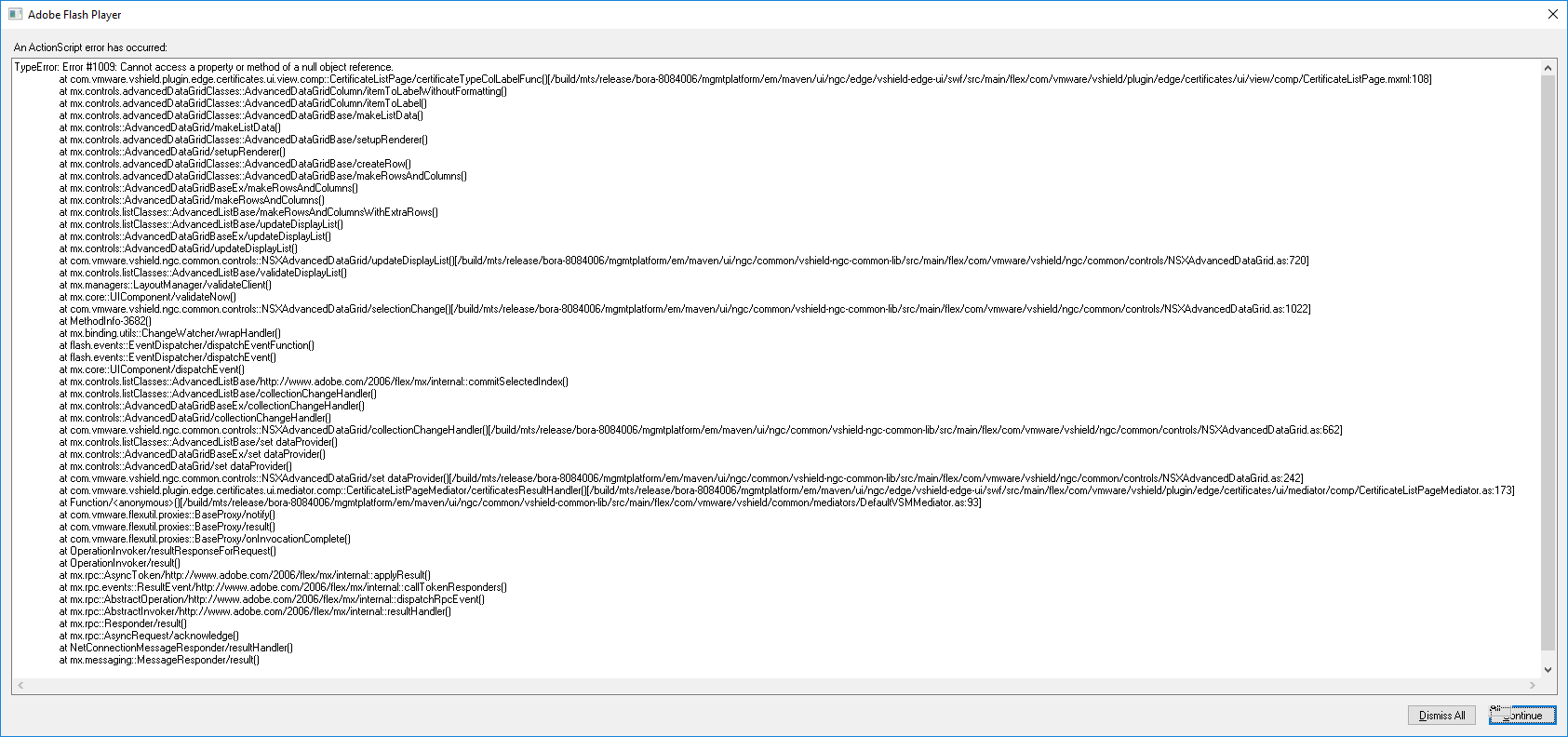Web Client becomes unresponsive when you see Edge certificates after upgrading NSX Manager
Article ID: 325728
Updated On:
Products
VMware NSX for vSphere
Issue/Introduction
Symptoms:

- After upgrading NSX Manager to 6.3.6 or 6.4.1, Web Client becomes unresponsive when you see Edge certificates. Additionally, you see Adobe Flash errors if you use Firefox.
- You can manage certificates by API.
- You can get global certificates by API (GET api/2.0/services/truststore/certificate/scope/globalroot-0) whose <certificateType> is undefined.
TypeError: Error #1009: Cannot access a property or method of a null object reference.
at com.vmware.vshield.plugin.edge.certificates.ui.view.comp::CertificateListPage/certificateTypeColLabelFunc()[/build/mts/release/bora-8084006/mgmtplatform/em/maven/ui/ngc/edge/vshield-edge-ui/swf/src/main/flex/com/vmware/vshield/plugin/edge/certificates/ui/view/comp/CertificateListPage.mxml:108]
at com.vmware.vshield.plugin.edge.certificates.ui.view.comp::CertificateListPage/certificateTypeColLabelFunc()[/build/mts/release/bora-8084006/mgmtplatform/em/maven/ui/ngc/edge/vshield-edge-ui/swf/src/main/flex/com/vmware/vshield/plugin/edge/certificates/ui/view/comp/CertificateListPage.mxml:108]
...
Environment
VMware NSX for vSphere 6.3.x
VMware NSX for vSphere 6.4.x
VMware NSX for vSphere 6.4.x
Cause
The plugin of NSX 6.3.6 and 6.4.1 can not manage certificates whose <certificateType> is NULL such as old PSC certificate.
Resolution
Issue is resolved in NSX 6.4.2 and NSX 6.3.7. If you are unable to upgrade, please consult the steps below to correct the problem:
The resolution is to use an API call to delete all of the unused certificates, whose <certificateType> is undefined.
To get all of global certificates, you can call "GET api/2.0/services/truststore/certificate/scope/globalroot-0".
To delete a specified certificate, you can call "DELETE https://localhost/api/2.0/services/truststore/certificate/<certificate-id>".
Example:
1. Confirm certificates whose <certificateType> is undefined.
$ curl -k -u 'admin:<password>' -X GET https://<nsxmgr-ip>/api/2.0/services/truststore/certificate/scope/globalroot-0 | xmllint --format - | egrep 'objectId|certificateType|certificate'
2. Then, you should delete certificate-11 because it doesn't have <certificateType>.
$ curl -k -u 'admin:<password>' -X DELETE https://<nsxmgr-ip>/api/2.0/services/truststore/certificate/certificate-11
$ curl -k -u 'admin:<password>' -X GET https://<nsxmgr-ip>/api/2.0/services/truststore/certificate/scope/globalroot-0 | xmllint --format - | egrep 'objectId|certificateType|certificate'
Workaround:
If the issue still exists after deleting all the "undefined" certificates, please open a Support Request with NSX support for further assistance.
The resolution is to use an API call to delete all of the unused certificates, whose <certificateType> is undefined.
To get all of global certificates, you can call "GET api/2.0/services/truststore/certificate/scope/globalroot-0".
To delete a specified certificate, you can call "DELETE https://localhost/api/2.0/services/truststore/certificate/<certificate-id>".
Example:
1. Confirm certificates whose <certificateType> is undefined.
$ curl -k -u 'admin:<password>' -X GET https://<nsxmgr-ip>/api/2.0/services/truststore/certificate/scope/globalroot-0 | xmllint --format - | egrep 'objectId|certificateType|certificate'
<certificates>
<certificate>
<objectId>certificate-1</objectId>
<certificateType>certificate_self_signed</certificateType>
</certificate>
<certificate>
<objectId>certificate-2</objectId>
<certificateType>certificate_self_signed</certificateType>
</certificate>
<certificate>
<objectId>certificate-11</objectId>
</certificate>
</certificates>
<certificate>
<objectId>certificate-1</objectId>
<certificateType>certificate_self_signed</certificateType>
</certificate>
<certificate>
<objectId>certificate-2</objectId>
<certificateType>certificate_self_signed</certificateType>
</certificate>
<certificate>
<objectId>certificate-11</objectId>
</certificate>
</certificates>
2. Then, you should delete certificate-11 because it doesn't have <certificateType>.
$ curl -k -u 'admin:<password>' -X DELETE https://<nsxmgr-ip>/api/2.0/services/truststore/certificate/certificate-11
$ curl -k -u 'admin:<password>' -X GET https://<nsxmgr-ip>/api/2.0/services/truststore/certificate/scope/globalroot-0 | xmllint --format - | egrep 'objectId|certificateType|certificate'
<certificates>
<certificate>
<objectId>certificate-1</objectId>
<certificateType>certificate_self_signed</certificateType>
</certificate>
<certificate>
<objectId>certificate-2</objectId>
<certificateType>certificate_self_signed</certificateType>
</certificate>
</certificates>
<certificate>
<objectId>certificate-1</objectId>
<certificateType>certificate_self_signed</certificateType>
</certificate>
<certificate>
<objectId>certificate-2</objectId>
<certificateType>certificate_self_signed</certificateType>
</certificate>
</certificates>
Workaround:
If the issue still exists after deleting all the "undefined" certificates, please open a Support Request with NSX support for further assistance.
Feedback
Yes
No
